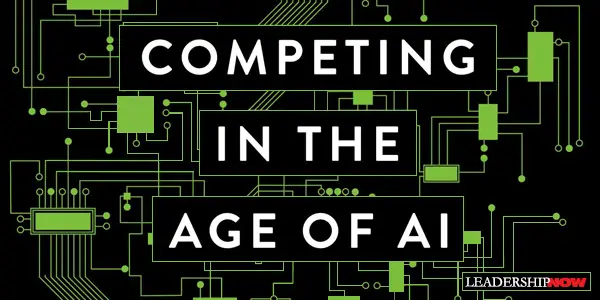 |
 |
01.27.20

Competing in the Age of AI
THE BIGGEST CHANGE being brought about by AI is not human replicas, but the emergence of digital operating models. These models aren’t the sexy, headline-grabbing side of AI, but they are profoundly affecting how we do business and the way leaders of the twenty-first century must think. Marco Iansiti and Karim Lakhani, professors at Harvard Business School, explore these changes in Competing in the Age of AI with examples of businesses in many industries. “When a business is driven by AI, software instructions, and algorithms make up the critical path in the way the firm delivers value.” And thus, how we think about the work we do and how we compete in the marketplace. The business plan describes the problem that is being solved for the customer—a reason to buy. The operating model is how that is accomplished. “The goal of the operating model is to deliver value at scale, to achieve sufficient scope, and to respond to changes by engaging in sufficient learning. If a business can grow in these areas it can increase its value. But here’s the thing. As these areas grow in a traditional business model, it also increases complexity and as a result, management challenges. At some point, the traditional model limits further growth. This is where AI is changing the nature of business and competition. With a digital operating model, “this new type firm is reaching new levels of scalability, achieving a vastly broader scope, and learning and adapting at a much faster rate than does a traditional firm. This is because the digital firm is transforming the critical path in the delivery of value.” This lengthy excerpt lays out the nature of the issue that leaders of traditional operating models face: Digital, AI-driven processes are more scalable than traditional processes. They enable greater scope (or variety), as they easily connect with a myriad of other digitized businesses, and they create powerful opportunities for learning and improvement, such as the ability to produce ever more accurate, complex, and sophisticated predictions and even gain fundamental understanding. In doing so, networks and AI are reshaping the operational foundations of firms, enabling digital scale, scope, and learning, and erasing deep-seated limits that have constrained firm growth and impact for hundreds of years. AI is breaking down the limits that are inherent in traditional operating models to drive new value, growth, and innovation. And when businesses with a digital foundation collide with more traditional firms, they can completely transform and reshape that industry. The authors provide case studies from the travel industry to the retail, entertainment, and automotive industries. The authors explain the issues faced when remaking a traditional operating model to exploit AI. They describe the journey to becoming an AI business. As we enter the age of AI, they point out five principles that we need to pay attention to: 1. Change Is No Longer Localized; It Is Systemic. “Inventions during the Industrial Revolution pertained to individual industries or at least clusters of industries. In contrast, digital transformation cuts across every industrial environment at the same time. Digital technology and AI are meeting an increasing variety of needs and enabling an incredible variety of use cases.” 2. Capabilities Are Increasingly Horizontal and Universal. “What is needed to compete in an AI-driven world has less to do with traditional industry specialization and more to do with a universal set of capabilities.” And this is especially important in a leadership context. “This new universality of capability reshapes a variety of operating tasks and reaches into strategy, business design, and even leadership. We are moving from an era of core competencies, differing from firm to firm and embedded deep in each organization, to an age shaped by data and analytics, powered by algorithms and hosted in the computing cloud for anyone to use.” 3. Traditional Industry Boundaries Are Disappearing Recombination Is Now the Rule. “The advice to executives in search of excellence was once to stick to their knitting and stay with businesses they knew. However, in the age of AI, organizations that cannot leverage customers and data across markets are likely to be at a disadvantage.” 4. From Constrained Operations to Frictionless Impact. “As digital operating models continue to displace traditional industrial processes, they also remove traditional operating constraints. This is why a new generation of firms has grown to unprecedented scale at unprecedented rates.” At the same time, even as frictionless systems “create unprecedented valuation multiples, digital scale, scope, and learning also create a slew of new leadership and governance challenges.” 5. Concentration and Inequality Will Likely Get Worse. In a pattern similar to what we saw in the Industrial Revolution, digital networks also lead to the “concentration of the flow of transactions and data, and from that to increased concentration of power and value.” All of this calls for—demands—a new degree of leadership wisdom. The implications of an AI-driven world are too complex and involve the exercising of values that only humans possess. Competing in the Age of AI is a fascinating book for not only implementing but understanding the transformations that are taking place in our digital world. 
Posted by Michael McKinney at 04:53 PM
|
BUILD YOUR KNOWLEDGE
 

How to Do Your Start-Up Right STRAIGHT TALK FOR START-UPS 
Grow Your Leadership Skills NEW AND UPCOMING LEADERSHIP BOOKS 
Leadership Minute BITE-SIZE CONCEPTS YOU CAN CHEW ON 
Classic Leadership Books BOOKS TO READ BEFORE YOU LEAD |